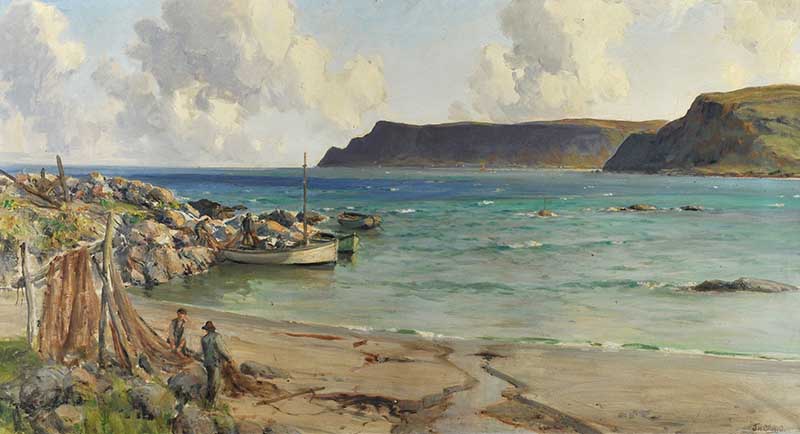To View the Catalogue Please Click Here
For over two centuries the name Dinsmore has been synonymous with the village of Kells in County Antrim.
During the Middle Ages an Augustinian community was established there. The Abbey survived until 1641 and what remains of the ruins are preserved in the grounds of Dinsmores’ mill. In 1780 Francis Dinsmore moved from Donegal to Kells and two years before the 1798 Rebellion he set up his woollen mill.
Successive generations developed the Dinsmore business into linen, beetling, dyeing and finishing.
Francis Dinsmore J.P. died in 2015 and the contents of Templemoyle House along with the extensive art collection, which he and his wife gathered over half a century, are to be sold at Ross’s in Belfast.
The collection extends to around 150 lots and includes works by Frank McKelvey, J.H. Craig, Frank Egginton, Kenneth Webb, Maurice Canning Wilks, Wycliffe Egginton, Douglas Alexander, A.P. Jury, Joseph William Carey, Andrew Nicholl, Markey Robinson and others.
The Dinsmores had a holiday home at Burtonport and there is a Donegal theme running through the work. From there they visited their friend Frank Egginton and there are several excellent full imperial examples of Egginton’s work.
Highlights of the sale include a James Humbert Craig, Drying Nets near Cushendun. At 30 x 54 inches this is a museum quality example of Craig’s work with an estimate of £15 000 - £20 000.

Art Historian Dickon Hall commented: “it is extremely unusual to see a painting by James Humbert Craig on the scale of Drying Nets near Cushendun and it has been suggested that this might well indicate it was a commission and perhaps designed to be hung in a specific place. It is remarkable that Craig has managed to maintain the directness and sense of the moment that one associates with his smaller work when dealing with such a large and challenging canvas.
While he achieves an effect of monumentality in the solid and almost monochromatic headland that cuts across near the centre of the canvas and anchors the composition, in many other passages Craig manages to achieve the same freshness and looseness of handling that is a familiar aspect of his work, the “swift notation of the insistent effect, the momentary flicker, the flash of light, the passing shadow that John Hewitt describes.
This is particularly evident in the left foreground, where fishermen are drying nets and working on their boats. The busy narrative details here are set against the vastness of the natural world, introducing a human scale that Craig depicts in a high-toned and more loosely-described manner. Yet there is a sense of harmony between the fishermen and the sea, with the movement of the water and clouds slow and calm and the mountainous headland seeming to shelter the bay.”
[1] John Hewitt, Art in Ulster I, Blackstaff Press, Belfast, 1991, p.83
Equally pleasing is Frank McKelvey’s view of Burtonport Harbour, County Donegal; another large picture at 23 x 34 inches. It carries a similar estimate of £15 000 - £20 000. Dickon Hall continues: “whereas the James Humbert Craig painting Drying Nets near Cushendun contrasts human activity with the natural world, Frank McKelvey’s Burtonport, County Donegal is much more concentrated on the human scale. Again, this is an unusually large canvas for the artist and it is packed with sailors, fishermen and spectators, as well as a number of boats of various sizes which form a triangle that, rather than leading easily on to the open sea, is surrounded by harbour warehouses, the end of the pier and an outcrop of crop with a strikingly high-toned covering of moss or grass.
The sea is visible past this busy foreground, but almost merges into the distant mountains beneath a bright, hazy sky. Although boats are visible as specks on the water beyond, the painting is entirely concerned with the activities of the harbour, with stronger colours and forms used to maintain the viewer’s engagement here.
The boats continue the diagonal that is established by the harbour wall and the warehouses behind that run in parallel, with this angle bisected by a series of verticals set up by masts and the doors and end of the building, as well as more fluidly by the numerous figures. This sense of enclosed safety and quietly bustling activity contributes to the mood of enjoyment McKelvey evokes so clearly in the work.”
The auction is on view in Ross’s Belfast rooms from Wednesday 2 March. Bidding shall be on-line and ends on Wednesday 9 March at 7.00pm. The antiques and furniture attached to the estate will be sold at a later date.
Any enquiries, please email dclarke@rosss.com
To View the Catalogue Please Click Here

